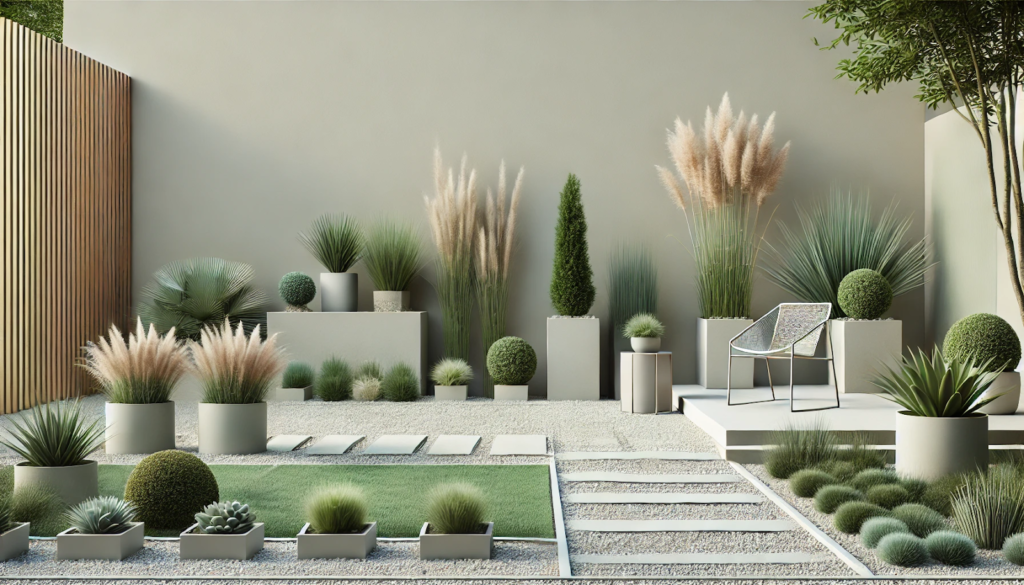A minimalist garden brings peace, clarity, and beauty through simplicity. Unlike traditional gardens packed with plants and décor, minimalist designs emphasize clean lines, open space, and thoughtful plant placement.
In this guide, you’ll learn how to design a calm, low-maintenance outdoor space that aligns with minimalist aesthetics and modern living.
1. What Is a Minimalist Garden?
Minimalist gardening is inspired by modern design and Zen philosophy. It focuses on intentional simplicity, using fewer elements for greater impact.
Key Features:
- Clean lines and symmetry
- Limited color palette
- Thoughtful use of negative space
- Fewer but more impactful plants
- Subtle textures and natural materials
Minimalism is about creating room to breathe—visually and emotionally.
2. Benefits of a Minimalist Garden
- Low maintenance – Less weeding, pruning, and watering
- Clutter-free design – More relaxing and functional
- Water-efficient – Great for drought-prone regions
- Suits small spaces – Perfect for courtyards, patios, and balconies
- Timeless aesthetic – Never feels outdated
It’s gardening with purpose and precision.
3. Planning Your Minimalist Garden
Step 1: Define the Space
- Start with clean shapes like squares or circles
- Use raised beds, decks, or gravel zones to break up the layout
- Keep symmetry or clear structure in mind
Step 2: Choose a Color Scheme
- Stick to 2–3 main colors: greens, whites, grays, beiges
- Let foliage and texture be the highlight
- Use pots, walls, or gravel to bring subtle contrast
Step 3: Embrace Negative Space
- Leave open areas for air and light
- Don’t feel the need to fill every corner
- Balance is more important than quantity
4. Best Plants for Minimalist Gardens
Choose plants with simple forms and consistent growth habits.
Great Options:
- Ornamental grasses (e.g., blue fescue, fountain grass)
- Succulents and cacti (e.g., echeveria, agave)
- Structured shrubs (e.g., boxwood, dwarf olive trees)
- Bamboo or horsetail reed – for vertical lines
- Ferns or hostas – for lush simplicity in shade
Use repetition—group the same plant in multiples for visual rhythm.
5. Hardscaping and Materials
Keep structures and surfaces clean and neutral.
Recommended Materials:
- Gravel or crushed stone paths
- Concrete or slate pavers
- Wood or composite decks in natural tones
- Modern planters in matte black, white, or gray
- Stone or ceramic water features with clean lines
Avoid clutter, ornaments, or overly ornate furniture.
6. Minimalist Garden Furniture and Décor
Select functional, sleek pieces that match the overall aesthetic.
- Bench seating made from wood, metal, or stone
- Small bistro sets for patios
- Neutral cushions in simple fabrics
- Soft lighting (solar path lights, lanterns, or LED strips)
- One feature element (e.g., bonsai tree, fire bowl, or large planter)
Let the space feel open and intentional.
7. Lighting for Evening Atmosphere
Use lighting to highlight structure, not overwhelm.
Ideas:
- Uplight a single tree or shrub
- Line a gravel path with discreet solar lights
- Use backlighting against a wall or feature
- Avoid overly bright or colored lights
Subtle lighting adds calm and depth after dark.
8. Maintenance Tips for Minimalist Gardens
Minimal doesn’t mean no maintenance—but it’s simpler.
- Weed regularly to preserve clean lines
- Trim plants to keep shapes defined
- Clean hard surfaces (gravel, pavers, walls)
- Check lighting and irrigation for function
- Reassess seasonally to maintain balance
Design with low-maintenance plants and durable materials to reduce upkeep.
Conclusion: Find Beauty in Simplicity
A minimalist garden is a retreat for the mind and senses—calm, functional, and effortlessly elegant. By focusing on structure, repetition, and intentional design, you can create a timeless space that’s easy to care for and deeply relaxing to enjoy.
Start with less. Let your garden breathe. And discover that sometimes, the most beautiful gardens are the simplest.






